![[SoundStage!]](../sslogo3.gif) The Y-Files The Y-FilesBack Issue Article |
September 2000 Xtreme Audio A 65-year-old heart-attack survivor bicycles non-stop from the tip of Chile to Seattle to prove to himself and others that the determination of his mind and heart rules superior over the matter of his failing body. An impassioned musical activist organizes a concert that draws millions and calmly embraces subsequent arrest and internment by the ruthless government his lyrics targeted. A crash-surviving motorcycle enthusiast commissions a special vehicle to continue his hobby with amputated legs while he lobbies congress to lift mandatory helmet laws. These individual causes may or may not resonate with you. But I’m sure you’ll instantly respond to the common thread behind all such foolhardy yet noble endeavors. In fact, we really cannot help but applaud them, can we? We’ll probably even harbor secret jealousies that those folks have found their paths and are walking them courageously without looking back. Don’t we all long to hit upon that certain something that will excite us enough to forge a headstrong commitment, something that renews our curiosity and fans our motivation to insatiable levels? In short, to find something that we absolutely love to do? Because the reward is a kind of soul satisfaction that comes only when a human being lives his passion and follows her bliss. Xtreme definition Let’s call such awakened passion-in-action "playing in the zone of Xtreme." As a safety valve, let’s also emphasize its intrinsically playful nature. It offsets the seriousness that all extreme endeavors must utilize to get accomplished. Now our definition of Xtreme becomes, in many important ways, the polar opposite of obscene. Curiously enough, the financial expenditures of extreme or obscene pursuits are often equally way off the charts. But Xtreme isn’t about money. We all know the difference, instinctively and immediately. It’s like an odor that the body registers and reacts to long before the mind explains. It’s how we know that a family erecting a hilltop mansion of 40 bedrooms just for themselves is obscene, not extreme. It’s how we distinguish between a genuine music lover’s audio system and that of a toy collector’s, though both may be priced stratospherically just the same. For the first, the system is a constant source of perpetual joy. This joy is infectious and shared without pretensions. This system is quite obviously a means to an end. It’s not an end unto itself. The money tied up in the equipment, though easily extreme, isn’t the concern. But it very much is to the other owner. He’s acutely aware and will tell you all about it at great lengths and every opportunity. For him, the components are an end unto themselves. His gear is meant to impress, to show off, to say something about him rather than disappear to let the music speak for itself. His conditional enjoyment is a bit like that of a compulsive. We sense something uneasy and out of place about him. We feel sorry and perhaps even a bit sad. It’s these observations and feelings that turn his system into something grotesque and obscene. It’s not the gear itself. It’s the relationship he has with it. Remember this difference. It’s what makes me want to tell you about a beautiful example of Xtreme I recently had a chance to witness. The destination Xtreme Audio is about what can happen when you know what you want, can’t find it anywhere, and obstinately declare what many men or women, about anything and everything conceivable, have declared many times before -- that if you want something done right, you gotta do it yourself. Most small boutique brands in high-end audio were, in fact, started that way. But sometimes the outcome of such a rallying cry is one single, solitary system, not a complete brand. At least that’s how it most often begins. It does with this story. The gestation
Audio Magic and Dynamic Sound Environments Certificates in service electronics and electronic circuits follow, as does the proverbial ten-year stint with audio retail, in his case Second Sound of Denver, Colorado. In 1983, Jerry leaves retail to devote himself full-time to Audio Magic, his cable company specializing in pure silver products. What the Audio Magic story doesn’t tell is Jerry’s continuous experimentation with his personal system all along. Needless to say, its current incarnation as a certifiable state-of-the-art rig wasn’t the product of instant shake-n-stir perfection. Rather, it is an ongoing obsession that has Jerry awake in the middle of the night with flashes of inspiration that propel him to hit the basement for an all-niter and experiment further. However, since October 1999, things have matured and stabilized such that Jerry, with help from a few partners, has incorporated a new company called Dynamic Sound Environments. D.S.E. now offers custom-designed systems for anyone wanting to duplicate Jerry’s personal system in their homes. More correctly, of course, his system serves as a reference point from whence adjustments are made to ensure that a customer’s system suits his or her particular requirements. It’s about as one-up custom as it gets. If you’ll forgive a brief glance at my usually cloudy crystal ball, I’m here to tell you that serious audio enthusiasts would cheat themselves out of a tremendous experience -- and possible opportunity if financially liberated enough -- by not making an appointment to hear this Dynamic Sound Environment for themselves. The phrasing here is deliberate. You’re not listening to individual components. You’re experiencing a soundroom that’s been fashioned from scratch to be an integral and total delivery vehicle for the event. "The room"
"The wall"
"The boiler room" Let’s turn the corner for a moment and walk
out the door, around the bend into the open portion of the basement. Check out the other
side of the wall from whence the juice rack provides power to all these transducers. From
top to bottom, you’ll spot a quartet of PSE Studio 5 monoblocks, rated 100/200Wpc
into 8/4 ohms, feeding the 18" and 24" woofers. Obviously, in terms of ultimate flexibility, an actively multi-amped system with multiple external crossovers is the cat’s meow -- or should I say roar? Would your lordship care for a smidgen more air in the top? How about a bit more bloom in the upper midrange? Some added dryness in the bass perhaps? With Jerry the aural butler at your beck and call -- or one of his associates, who make two free house calls within the first year of installation -- the degree of possible sonic fine-tuning is as easy as rotating a dial or changing a dip switch. It’s light years beyond regular component systems that are more or less fixed once assembled. Keeping this in mind, the crossover points and slopes in Jerry’s room are as follows: the Marchand crossover provides 6dB slopes at 7.5kHz for the ribbon tweeter and 1kHz for the ribbon mids, and a 24dB slope for the 200Hz band-path on the dual 10" woofers. The Intrinsic Sound is set for 200Hz at 24dB for the high-pass and 50Hz at 24dB for the low-pass on the Hartley woofers. "The mouth"
A preliminary verdict My column isn’t the proper place for a regular review because I work in the industry. I won’t approach describing the experience from that angle then. Still, there are important things to be said. For one, forget the notion that only large rooms can support truly subterranean bass. This room disproves all such claims with a vengeance. That’s especially noteworthy because of its very modest dimensions. I can easily envision its base geometry being replicated in a standard home that’s not a major mansion on the hill. After all, we’re talking the size of a normal bedroom. Many people have a spare that’s rarely used. Of course, the D.S.E. team will work with potential clients based on their needs and situation. It’s very likely that many such commissioned spaces will be considerably larger. My point is simply that they won’t have to be in order to work. Secondly, in-wall systems can soundstage and portray depth every bit as convincingly as freestanding systems. I’m the first to admit that this sounds disingenuous and like hyperbole. Honestly, I would have laughed it off as impossible until I heard what I heard. Thirdly, seriously scary and enveloping
home-theater sound is possible without surround, center and subwoofer speakers.
What’s more, a state-of-the-art music/movie system can not only be one and the same,
it can also be presented in a harmonious and elegant fashion that is fully integrated into
the environment. I propose a new term for this: The Personal Entertainment Temple.
Don’t laugh. Think about your concepts of a temple. It’s a place of serenity,
seclusion, peace and quiet, a well-served environment that’s conducive to rest and
relaxation, inspiration and renewal. Well, that’s exactly what D.S.E. has created,
the antithesis of the ubiquitous audiophile dream room of colossal freestanding tower
speakers and multiple casket-sized subs, racks of amplifiers, elevated garden-hose cables
and forests of bass traps. Here, the heavyweight artillery of power equipment is
conveniently removed from sight. It’s parked behind the speaker wall where cable runs
remain short and components accessible and ventilated. The only pieces actually taking up
floor space inside are the CD player and preamp. That’s about as minimalist as it
gets. It explains further why a relatively small space works so well in this
configuration: How does it sound? It’s amongst the very
best systems I’ve ever heard, period. Never mind those gargantuan eggshell woofers
that, while some of the most expensive drivers in the world, conjure up bloat and boom. Not.
This system is nimble as a bantamweight fighter and subtle as a rainbow. It serves string
quartet as well as small jazz combos or solo piano. Lastly, defying preconceived notions that a laterally aligned speaker system can’t image precisely, the D.S.E speaker wall is as intelligible as a pair of mini monitors. But the seamless soundstage it throws is of such a magnitude that little monitors don’t even need apply. The midrange panels are positioned at the proper height and angled towards the listener like the tweeter panels. This creates both very realistic height perception and superb imaging precision and low-level intelligibility. It is very odd that such a massive in-wall system should even remotely work. Horizontal line-source theories predict it can’t. However, it not only works, it steals the show. Or, as Jerry would say, "pretty awesome, man." How much? 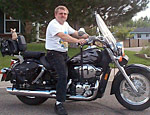 Despite his obvious maturity and impeccable professionalism, Jerry Ramsey is
about the most passionate juvenile audio delinquent you‘ll ever meet. Noting me ogle
his new custom motorcycle in the garage, he hands me the keys for a quick spin around the
block. When I ask him how much a system like this would cost a prospective client, he
makes a beeline to his instant-hippie baseball madcap. He grabs the lava lamp to transport
me back in time, shoots me this insane I’m-high-on-some-strange-stuff grin and parts
his fingers in the universal sign for victory: "Two grand. He isn’t fibbing. He means two really big, grand
grands -- something in the neighborhood of $200,000. Despite his obvious maturity and impeccable professionalism, Jerry Ramsey is
about the most passionate juvenile audio delinquent you‘ll ever meet. Noting me ogle
his new custom motorcycle in the garage, he hands me the keys for a quick spin around the
block. When I ask him how much a system like this would cost a prospective client, he
makes a beeline to his instant-hippie baseball madcap. He grabs the lava lamp to transport
me back in time, shoots me this insane I’m-high-on-some-strange-stuff grin and parts
his fingers in the universal sign for victory: "Two grand. He isn’t fibbing. He means two really big, grand
grands -- something in the neighborhood of $200,000.
Proper perspective Before you swallow hard or flash on that obscene
word, let’s return to our opening distinction. Yes, two of those grands can
buy you a small house somewhere in the boondocks. Or, to really be obscene, you could
thunder down the local on-ramp in a screaming-red Ferrari Testarossa. But there are also
countless ways in which to spend such a sum on a "regular" stereo system. A pair
of Wilson Grand SLAMMs or JMlabs Utopias alone will get you a good third of the way there.
Adding other heavy-hitter components will result in a more-or-less haphazard combination
of gear that’s condemned to eternal mediocrity in a room that interferes instead of
enables. I’ve heard a fair share of such systems that looked impressive on paper.
They didn’t sound remotely as good as this. Also, they tend to be ugly and intrusive.
You also know that they’re as far removed from obscene as that famous Austrian mountaineer Reinhold Messner, who single-handedly conquered ten of the world’s highest peaks without oxygen support. Xtreme, yes. Obscene, no. It’s not the money you spend; it’s the happiness you derive from what you do with it. When that happiness radiates from you thickly like a saint’s aura or the pungent excess of a floral bouquet, when it touches and impacts other people to bring light, love and laughter, it simply makes you into a better human being, period. And that’s entirely beyond money. That’s absolutely priceless. If listening to music is what gets you into that state, you owe it to yourself to call Dynamic Sound Environments. I predict you’ll come away thunderstruck. It’s great fun, too. Infectious. Meeting Jerry and his team is pretty far out. Consider yourselves warned then. ...Srajan Ebaen Contact information: Dynamic Sound Environments
|
|
![[SoundStage!]](../sslogo3.gif) All Contents All ContentsCopyright © 2000 SoundStage! All Rights Reserved |
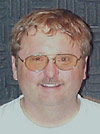 Take Jerry Ramsey,
greenhorn audiophile with an Electric Avenue-special rig. One day he invites his future
brother-in-law over for a show-and-tell audio session. The scene is carefully set to
impress the visitor shitless. Except rather the opposite occurs. Jerry swears in secret
disgust and humiliation to never invite this guy over again. Some weeks later though, a
return visit to his sister’s husband-to-be has become unavoidable. Now it’s
Jerry’s turn to fake enthusiasm. Gary Tyler’s system, behind a thin wall-to-wall
curtain, remains mysteriously hidden from view. Before he realizes what is about to hit
him like a freight train, Jerry is quickly ushered to park his cheeks on the hot seat. Two
seconds into the first track, his jaw hits the collarbone and leaves its mark -- forever.
Eureka, another audiophile junkie is born. When Gary eventually parts the curtains, Jerry
discovers stacks of massive McIntosh gear and custom speakers with Hartley drivers. Like a
fish wiggling on a line, he’s hooked. Except the Great Audiophile Fisherman upstairs
won’t release him back into the pond of forgetfulness -- Jerry’s as enthusiastic
and in love with great music and intoxicating sound today as he was back then many years
ago.
Take Jerry Ramsey,
greenhorn audiophile with an Electric Avenue-special rig. One day he invites his future
brother-in-law over for a show-and-tell audio session. The scene is carefully set to
impress the visitor shitless. Except rather the opposite occurs. Jerry swears in secret
disgust and humiliation to never invite this guy over again. Some weeks later though, a
return visit to his sister’s husband-to-be has become unavoidable. Now it’s
Jerry’s turn to fake enthusiasm. Gary Tyler’s system, behind a thin wall-to-wall
curtain, remains mysteriously hidden from view. Before he realizes what is about to hit
him like a freight train, Jerry is quickly ushered to park his cheeks on the hot seat. Two
seconds into the first track, his jaw hits the collarbone and leaves its mark -- forever.
Eureka, another audiophile junkie is born. When Gary eventually parts the curtains, Jerry
discovers stacks of massive McIntosh gear and custom speakers with Hartley drivers. Like a
fish wiggling on a line, he’s hooked. Except the Great Audiophile Fisherman upstairs
won’t release him back into the pond of forgetfulness -- Jerry’s as enthusiastic
and in love with great music and intoxicating sound today as he was back then many years
ago.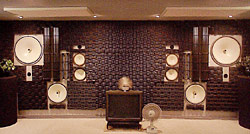 The first thing
that strikes you upon entering is its modest size. A build-out of an open-space
basement’s section, the dimensions are 17'W x 15'D x 8'H, with the system on the long
wall. If you look closely enough, you’ll notice peculiarities. For one, the front
wall isn’t straight, but slightly concave. It’s angled inwards 10 degrees,
recessed at its center point by about 6" behind an imaginary corner-to-corner
straight line. This room puts into ingenious practice those standard acoustical precepts
that advise to avoid parallel walls. So the same slightly off-kilter arrangements are
continued with the side walls. They move inwards by 10 degrees towards the rear wall,
while the ceiling goes up by 10 degrees towards the back. The only thing not angled is the
concrete floor covered with a 5/8" water-resistant pad and carpet. The side walls are
steel-stud construction on standard 16" centers. The front wall is the 2x6 wood-stud
type covered by 5/8" particleboard and Sonex foam diffuser panels. All walls and the
ceiling use R13 fiberglass insulation. It took four guys nine full-time days to complete
the room from the drawings.
The first thing
that strikes you upon entering is its modest size. A build-out of an open-space
basement’s section, the dimensions are 17'W x 15'D x 8'H, with the system on the long
wall. If you look closely enough, you’ll notice peculiarities. For one, the front
wall isn’t straight, but slightly concave. It’s angled inwards 10 degrees,
recessed at its center point by about 6" behind an imaginary corner-to-corner
straight line. This room puts into ingenious practice those standard acoustical precepts
that advise to avoid parallel walls. So the same slightly off-kilter arrangements are
continued with the side walls. They move inwards by 10 degrees towards the rear wall,
while the ceiling goes up by 10 degrees towards the back. The only thing not angled is the
concrete floor covered with a 5/8" water-resistant pad and carpet. The side walls are
steel-stud construction on standard 16" centers. The front wall is the 2x6 wood-stud
type covered by 5/8" particleboard and Sonex foam diffuser panels. All walls and the
ceiling use R13 fiberglass insulation. It took four guys nine full-time days to complete
the room from the drawings. 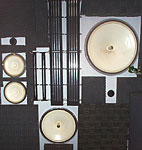 Chances are that
all of the above escaped your notice when you first walked in. The speaker system of the
front wall is to a jaded audiophile what centerfolds of Pamela Anderson Lee and Brad Pitt
are to hormone-crazed teens -- you can’t help but stare. Here’s the laundry list
of what you’ll count for transducers per channel if your brain didn’t stop cold
in its tracks. From the treble on down: dual JBL 2405 super tweeters, dual Eminent
Technology planar-magnetic ribbon tweeters, dual Eminent Technology planar-magnetic
midrange ribbons, twin 10" Hartley woofers and one 18" and 24" woofer from
the same maker. Before you try to minimize this impact by countering that you’re
staring at an in-wall rig, take a closer look. Every driver is slightly angled inwards
towards the listening position. It’s most easily discernible with the planar panels
that are mounted on stand-offs away from the wall. But it’s true for them all -- the
precise alignment is the end result of hundreds of hours of experimenting and tweaking.
Chances are that
all of the above escaped your notice when you first walked in. The speaker system of the
front wall is to a jaded audiophile what centerfolds of Pamela Anderson Lee and Brad Pitt
are to hormone-crazed teens -- you can’t help but stare. Here’s the laundry list
of what you’ll count for transducers per channel if your brain didn’t stop cold
in its tracks. From the treble on down: dual JBL 2405 super tweeters, dual Eminent
Technology planar-magnetic ribbon tweeters, dual Eminent Technology planar-magnetic
midrange ribbons, twin 10" Hartley woofers and one 18" and 24" woofer from
the same maker. Before you try to minimize this impact by countering that you’re
staring at an in-wall rig, take a closer look. Every driver is slightly angled inwards
towards the listening position. It’s most easily discernible with the planar panels
that are mounted on stand-offs away from the wall. But it’s true for them all -- the
precise alignment is the end result of hundreds of hours of experimenting and tweaking.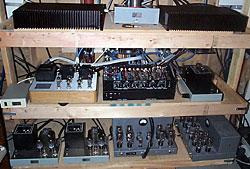 One Atma-Sphere M-60 OTL tube amp per
channel powers the twin 10" Hartleys, while the midrange and tweeter ribbons are
powered from Velvet Touch EL34 mono tube amps. The dual JBL super tweeters are driven from
a 6BQ5/EL84 stereo amp by the same Colorado-based company. Incidentally, Velvet Touch is
headed by Jerry’s old nemesis-turned-friend, my-system-beats-yours Gary Tyler. A
total of five dedicated 20-amp lines with true-earth grounds provide the AC for the boiler
room, and the front-end stack in the main room. Level two of "the rack" houses
the speaker system’s brain. A Marchand XM 126 active three-way tube crossover
represents the right brain hemisphere. It’s no longer stock, but has been rewired
with Audio Magic pure silver wire and further upgraded with WBT RCA jacks and 16 Mullard
12AX7 tubes. The brain’s left hemisphere is an Intrinsic Sound solid-state active
crossover. All interconnects and power cords are Audio Magic Clairvoyant and Illusion.
One Atma-Sphere M-60 OTL tube amp per
channel powers the twin 10" Hartleys, while the midrange and tweeter ribbons are
powered from Velvet Touch EL34 mono tube amps. The dual JBL super tweeters are driven from
a 6BQ5/EL84 stereo amp by the same Colorado-based company. Incidentally, Velvet Touch is
headed by Jerry’s old nemesis-turned-friend, my-system-beats-yours Gary Tyler. A
total of five dedicated 20-amp lines with true-earth grounds provide the AC for the boiler
room, and the front-end stack in the main room. Level two of "the rack" houses
the speaker system’s brain. A Marchand XM 126 active three-way tube crossover
represents the right brain hemisphere. It’s no longer stock, but has been rewired
with Audio Magic pure silver wire and further upgraded with WBT RCA jacks and 16 Mullard
12AX7 tubes. The brain’s left hemisphere is an Intrinsic Sound solid-state active
crossover. All interconnects and power cords are Audio Magic Clairvoyant and Illusion.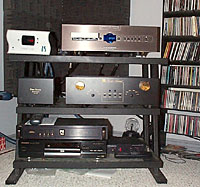 The digital
front-end is a BAT VK-D5SE CD player with the optional BAT-Pak capacitor bank upgrade and
extra damping rings and strips on tubes and power supply. Emmanuel Go’s First Sound
company out of Seattle, WA provides preamplification with the Presence Deluxe tube preamp
and SPS 2.0 outboard power supply, powered with one OA2 and Mullard 6922 per channel.
Power for the preamp is sourced through a PS Audio P300 AC regenerator set at 60Hz line
frequency, while the PS Audio and BAT components are plugged into another dedicated 20-amp
line outlet. Interconnects and power cords are again Audio Magic Clairvoyant.
The digital
front-end is a BAT VK-D5SE CD player with the optional BAT-Pak capacitor bank upgrade and
extra damping rings and strips on tubes and power supply. Emmanuel Go’s First Sound
company out of Seattle, WA provides preamplification with the Presence Deluxe tube preamp
and SPS 2.0 outboard power supply, powered with one OA2 and Mullard 6922 per channel.
Power for the preamp is sourced through a PS Audio P300 AC regenerator set at 60Hz line
frequency, while the PS Audio and BAT components are plugged into another dedicated 20-amp
line outlet. Interconnects and power cords are again Audio Magic Clairvoyant.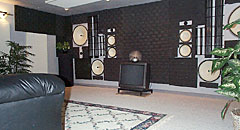 There
are no floorstanding speakers that require breathing room behind them, which would put
them smack into the face of the listener. There’s a couch, a CD rack, a few
tastefully placed lights, some ceiling dome spots with adjustable-intensity lighting
controlled from a high-end dimmer panel, some plants and minimal room treatments.
That’s it.
There
are no floorstanding speakers that require breathing room behind them, which would put
them smack into the face of the listener. There’s a couch, a CD rack, a few
tastefully placed lights, some ceiling dome spots with adjustable-intensity lighting
controlled from a high-end dimmer panel, some plants and minimal room treatments.
That’s it. 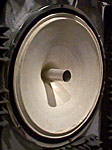 But fasten your seat belts when the aural wind conditions create
massive swells. The dynamic headroom kicks in like a turbocharger. Giving control over the
master volume to a reckless youngster is positively dangerous. I flashed on Jules
Verne’s Captain Nemo, 10.000 leagues below the waves, thundering away on his
futuristic submarine’s private organ. Let’s face it, normal systems are all
plagued with dynamic compression problems and concomitant distortion figures that rear
their ugly heads when the going gets loud. Conversely, when called for, this system
produces crystalline-pure sound pressure waves of such impact that rather than absorbing
them with your ears alone, you feel them bodily, just like in real life. It’s a
quality I’ve only experienced once before, in a system I will describe in part II of
"Xtrme Audio." Rather than having your ears clipped when the going gets intense,
you feel the acoustical pressure waves on your skin. Your body feels overrun by energy and
creates those exhilarating sensations that usually only occur live. Listening is no longer
an isolated ear experience but a whole-body response.
But fasten your seat belts when the aural wind conditions create
massive swells. The dynamic headroom kicks in like a turbocharger. Giving control over the
master volume to a reckless youngster is positively dangerous. I flashed on Jules
Verne’s Captain Nemo, 10.000 leagues below the waves, thundering away on his
futuristic submarine’s private organ. Let’s face it, normal systems are all
plagued with dynamic compression problems and concomitant distortion figures that rear
their ugly heads when the going gets loud. Conversely, when called for, this system
produces crystalline-pure sound pressure waves of such impact that rather than absorbing
them with your ears alone, you feel them bodily, just like in real life. It’s a
quality I’ve only experienced once before, in a system I will describe in part II of
"Xtrme Audio." Rather than having your ears clipped when the going gets intense,
you feel the acoustical pressure waves on your skin. Your body feels overrun by energy and
creates those exhilarating sensations that usually only occur live. Listening is no longer
an isolated ear experience but a whole-body response. What happens when a few guys with rock-solid experience, trained
ears and a nearly maniacal passion design a complete system from the ground up that
accounts for all variables including the room? Simply this -- it becomes an entirely
different ball game, the difference between amateur baseball and the big leagues. Once you
bathe in the tangible excitement and pride that emanates from the D.S.E. team, feel the
contagious vibe of their unabashed passion for music, you know without a doubt that these
folks are playing it Xtreme.
What happens when a few guys with rock-solid experience, trained
ears and a nearly maniacal passion design a complete system from the ground up that
accounts for all variables including the room? Simply this -- it becomes an entirely
different ball game, the difference between amateur baseball and the big leagues. Once you
bathe in the tangible excitement and pride that emanates from the D.S.E. team, feel the
contagious vibe of their unabashed passion for music, you know without a doubt that these
folks are playing it Xtreme.